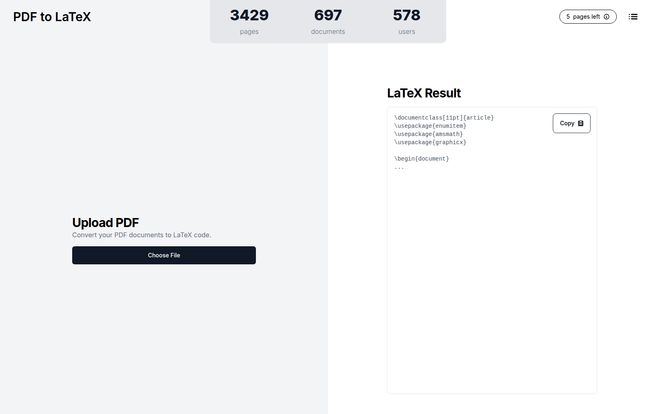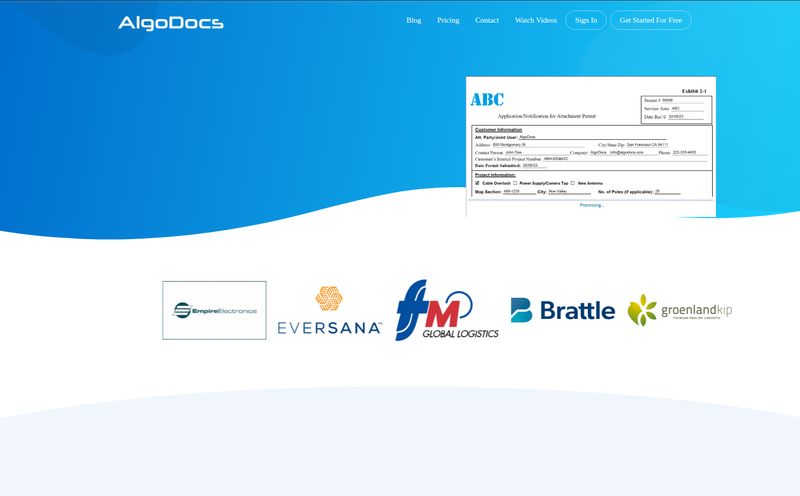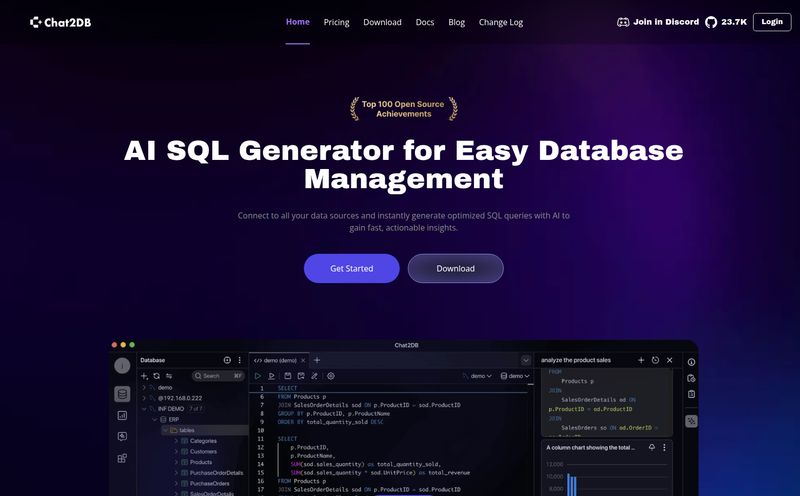Alright, let’s talk. If you’ve ever spent an afternoon—or let’s be honest, a whole weekend—hunched over your keyboard, meticulously trying to recreate a beautifully formatted PDF into LaTeX, you know the pain. The endless cycle of compiling, checking the output, and spotting yet another misplaced brace or a `\frac` that just doesn't look right. It’s a special kind of technical purgatory. I've been there, wrestling with `\documentclass` more times than I care to admit.
So when I stumbled upon a tool called pdflatex.com, my curiosity was piqued. An AI-powered converter that promises to turn this soul-crushing task into a simple file upload? It sounds almost too good to be true. Is it the magic bullet for academics, researchers, and students everywhere, or just another tech gimmick? I decided to put it to the test.
What Exactly is PDF to LaTeX and How Does It Work?
At its heart, this is a pretty straightforward utility. You feed it a PDF, and it spits out the corresponding LaTeX code. But the magic isn't in what it does, but how it does it. This isn’t some janky script from a 2005 forum post. The platform uses a multimodal LLM (Large Language Model)—basically, a fancy AI brain.
It first looks at your PDF page by page, almost like it's taking a high-res photograph of each one. Then, this AI model, which has been trained on a massive dataset of documents, analyzes these images and translates the structure, text, and even the complex mathematical formulas into clean LaTeX code. It’s a process that mimics how a human might deconstruct and rebuild a document, but at a speed we can only dream of.
This is built for a specific crowd: the people already living in the world of TeX. If you’re a grad student trying to incorporate a source paper into your thesis, a professor updating old lecture notes, or an engineer converting a spec sheet, this is aimed squarely at you.

Visit PDF to LaTeX
The Good, The Bad, and The TeX-nical
No tool is perfect, right? So let's break down what I found, the good and the not-so-good. I think it's important to have a balanced view, especially when you're putting your money and, more importantly, your time on the line.
The Things I Genuinely Liked
First off, the simplicity is just chef's kiss. The interface is clean. There’s no clutter, no confusing options. It's literally an upload button and a result window. You don't need a manual to figure it out. But the real star is the underlying AI. It does a surprisingly good job of capturing the layout and structure of a document, which is often the most time-consuming part to replicate.
But here’s the feature that really made me sit up and pay attention: their data privacy policy. In an era where every “free” tool seems to be training its AI on your private data, pdflatex.com makes a clear promise: they do not train their model on your documents. They even have a clear data deletion option. For anyone working with sensitive research, pre-publication papers, or proprietary data, this is a massive, massive win. It shows a level of respect for the user that is becoming increasingly rare.
And then there’s the pricing. It’s a simple pay-as-you-go system. You buy a block of pages, and they sit in your account forever. No monthly subscription breathing down your neck, no pressure to “use it or lose it.” I love this model. It’s honest and perfect for the sporadic nature of academic and research work. You might need to convert 50 pages one month and then none for the next six. This fits that workflow perfectly.
A Few Reality Checks (Because Nothing’s Perfect)
Okay, let's be real. This tool isn't going to do your entire job for you. Think of it as an incredibly skilled assistant, not a replacement for your own expertise. The generated LaTeX code is a fantastic starting point, but it almost always needs a little finessing. You'll probably need to adjust some formatting, tweak alignments, or clean up a complex table. You still need to be the human in the loop.
A significant thing to know is that images from your PDF are not carried over. The tool focuses solely on generating the text and layout code. You’ll have to extract and insert your images into the LaTeX project manually. It's a bit of a letdown, but understandable given the complexity of handling image files.
You might also run into some dependency issues. The generated code could call for a specific package or font that you don't have installed in your TeX distribution. This can lead to the classic LaTeX experience of hunting down error messages. But hey, if you're a LaTeX user, you're probably already a pro at that, right? Lastly, and this is important, once you convert a page, that credit is used. There are no refunds, which makes sense from a business standpoint since teh compute cost is real, but it’s something to be aware of before you start converting a massive document.
Let's Talk Money: The Pricing Breakdown
I really appreciate the straightforward pricing here. It's transparent and feels fair. You're not signing up for a subscription you'll forget about; you're just buying a resource to use whenever you need it.
| Page Count | Price | Cost Per Page |
|---|---|---|
| 10 Pages | $2.00 | $0.20 |
| 25 Pages | $3.75 | $0.15 |
| 100 Pages | $13.00 | $0.13 |
When you weigh this against the hours you could spend manually recreating a document, the value becomes pretty clear. Is spending $13 to save yourself a week of tedious work on your 100-page dissertation worth it? In my book, that's an absolute yes. Time is the one resource we can't buy more of.
Who Should Actually Use This PDF to LaTeX Tool?
This tool isn’t for everyone, and that's okay. It shines for a particular type of user.
- The Overwhelmed Grad Student: You're facing a deadline, you have a stack of source PDFs, and you just need to get their contents into your thesis as a starting point for your literature review. This tool is your new best friend.
- The Seasoned Professor: You have lecture notes from a decade ago saved as PDFs. You want to update them, but the thought of re-typing everything, especially the equations, makes you want to retire early. This can give those old documents a new, editable life.
- The R&D Engineer: You need to pull tables and specifications from a manufacturer's PDF datasheet into a technical report. This can handle the grunt work of formatting, letting you focus on the actual analysis.
The common thread here? These are people who are already proficient in LaTeX. This tool doesn't teach you TeX. It's a productivity booster for those who already speak the language of backslashes and curly braces.
My Final Take: A Powerful Assistant, Not a Magic Wand
After playing around with pdflatex.com, I’m genuinely impressed. It’s not a one-click magic wand that creates a perfect, ready-to-compile document every single time. That’s an unrealistic expectation for any conversion tool.
Instead, what you get is something far more valuable: a powerful assistant. It’s like a sous-chef for your document preparation. It does all the tedious chopping, dicing, and initial prep work—the stuff that consumes hours of your time. It hands you a well-organized set of ingredients. You, as the head chef, still need to combine them, adjust the seasoning (the code), and plate the final dish. It saves you from the most boring part of the process, freeing up your mental energy for the work that actually matters.
For the price, and especially for the privacy guarantees, it's a fantastic utility to have in your academic or technical toolkit.
Frequently Asked Questions (The Stuff You're Probably Wondering)
- Is pdflatex.com safe to use with my research?
- Based on their privacy policy, yes. They explicitly state they do not train their AI models on user data and provide a data deletion option. This makes it one of the safer options out there for sensitive documents.
- Do I need to know LaTeX to use this tool?
- Absolutely. The tool outputs raw LaTeX code. If you don't know how to work with that code, compile it, and troubleshoot errors, the output won't be very useful to you. It's a tool for existing LaTeX users.
- What happens to the images in my PDF?
- They are not converted or included in the LaTeX output. You will need to extract the images from your PDF separately and manually add them to your LaTeX project using the `\includegraphics` command.
- Is the pricing a monthly subscription?
- Nope! It’s a pay-as-you-go model. You buy a specific number of page credits (e.g., 10, 25, or 100), and those credits never expire. You just use them as you need them.
- Can it handle complex mathematical formulas?
- Yes, that's one of its strengths. The AI is designed to recognize and convert mathematical notation into the appropriate LaTeX commands. However, you should always double-check complex or unusual formulas for accuracy after conversion.
Conclusion
In the end, pdflatex.com knows exactly what it is: a sharp, focused tool designed to solve one very annoying problem. It trades a small amount of money for a huge amount of saved time and frustration. While it has its limitations—like the manual handling of images and the need for final human review—its strengths in privacy, simplicity, and pricing make it a compelling choice. If you live and breathe LaTeX, this might just be the best few dollars you'll spend all semester.
Reference and Sources
- PDF to LaTeX Official Website
- The LaTeX Project Official Website
- Adobe's Information on the PDF Format



